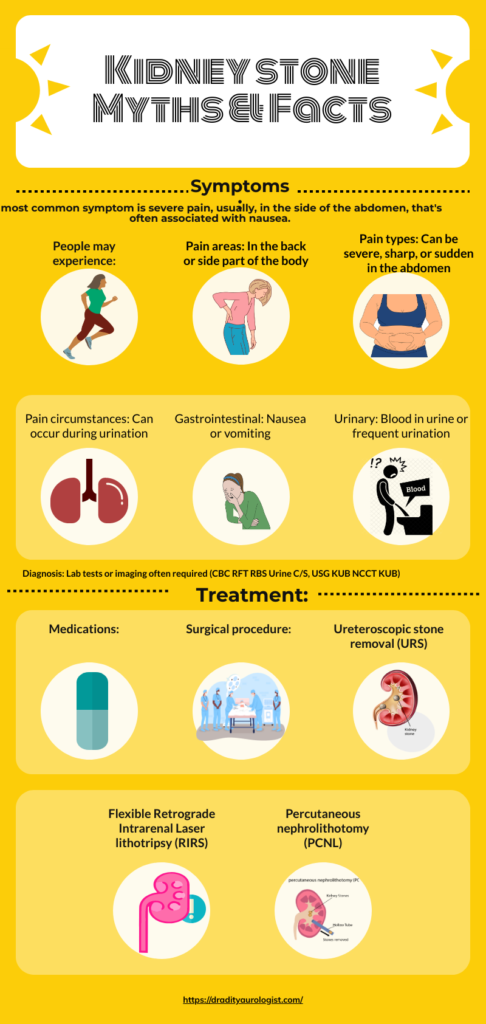Kidney stone Myths & Facts
Kidney stones are hard deposits of minerals and acid salts that stick together in concentrated urine. They can be painful when passing through the urinary tract, but usually, don’t cause permanent damage.
- The most common symptom is severe pain, usually, in the side of the abdomen, that’s often associated with nausea.
- Treatment includes pain relievers and drinking lots of water to help pass the stone of small size up to 5-mm safely.
- Medical Treatment or Surgical procedures may be needed to remove or break the larger stones.

Symptoms:
The most common symptom is severe pain, usually, in the side of the abdomen, that’s often associated with nausea.
- People may experience:
- Pain areas: In the back or side part of the body
- Pain types: Can be severe, sharp, or sudden in the abdomen
- Pain circumstances: Can occur during urination
- Gastrointestinal: Nausea or vomiting
- Urinary: Blood in urine or frequent urination
- Diagnosis: Lab tests or imaging often required (CBC RFT RBS Urine C/S, USG KUB NCCT KUB)
Treatment:
1. Medications: There is no medication to “dissolve” the stone (beware of fraudulent advertisements)A kidney stone can hurt you more with Beer/Alcohol
2. Blockers: Relaxes Urinary tract to ease the passage of stone
3. Nonsteroidal anti-inflammatory drug: Diclofenac/ Ketorolac: Relieves pain, decreases inflammation and reduces fever.
Surgical procedure:
1. Extracorporeal Shockwave Lithotripsy (ESWL): Using shock waves to break up kidney stones and gallstones, so they pass more easily. More effective for soft stones and stones upsize 15-20 mm.
- Hospital Stay: 2 Hrs
- Return to work: Same Day
2. Ureteroscopic stone removal (URS): Using a small semi-rigid scope inserted into the ureter through the urethra to remove a Ureteric stone of Lower and Mid-Ureter stone.
- Hospital Stay:12 Hrs
- Return to work: Next Day
3. Flexible Retrograde Intrarenal Laser lithotripsy (RIRS): Using heat from a laser to break up and remove stones in the kidney, urinary tract.
- Hospital Stay:12-24 Hrs
- Return to work: Next Day
4. Percutaneous nephrolithotomy (PCNL): Preferred procedure for kidney stones larger than 20mm. stone operated through a small hole from the back.
- Hospital Stay: 24-48 Hrs
- Return to work: After 3 days
- Whom to contact: Specialists:
- Emergency medicine doctor: Treats patients in the emergency department for the relief of symptoms
- Urologist: Final treatment of stone Kidney stone.
1. Diet: There is no perfect diet. It has to be customized based on the type of stone.
2. Plenty of liquids: Avoid cold drinks and fruit juices containing preservatives. Go natural. Whole fruit is always better than Juice.
Note: The information you see describes what usually happens with a medical condition, but doesn’t apply to everyone. This information isn’t medical advice, so make sure to contact a healthcare provider if you have a medical problem. If you think you may have a medical emergency, call your doctor or an emergency number immediately.
